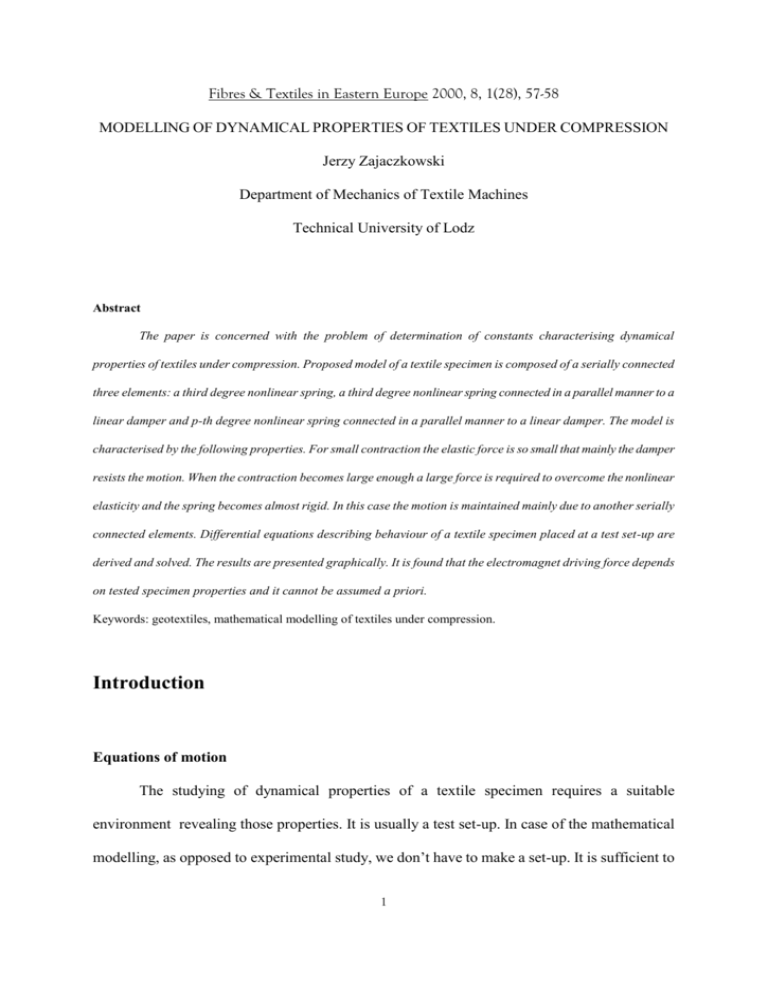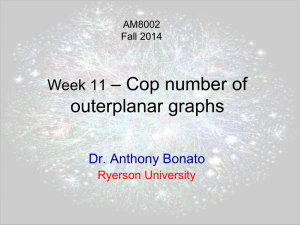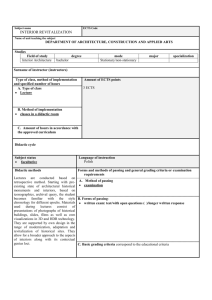modelling of dynamical properties of textiles under compression
advertisement

Fibres & Textiles in Eastern Europe 2000, 8, 1(28), 57-58 MODELLING OF DYNAMICAL PROPERTIES OF TEXTILES UNDER COMPRESSION Jerzy Zajaczkowski Department of Mechanics of Textile Machines Technical University of Lodz Abstract The paper is concerned with the problem of determination of constants characterising dynamical properties of textiles under compression. Proposed model of a textile specimen is composed of a serially connected three elements: a third degree nonlinear spring, a third degree nonlinear spring connected in a parallel manner to a linear damper and p-th degree nonlinear spring connected in a parallel manner to a linear damper. The model is characterised by the following properties. For small contraction the elastic force is so small that mainly the damper resists the motion. When the contraction becomes large enough a large force is required to overcome the nonlinear elasticity and the spring becomes almost rigid. In this case the motion is maintained mainly due to another serially connected elements. Differential equations describing behaviour of a textile specimen placed at a test set-up are derived and solved. The results are presented graphically. It is found that the electromagnet driving force depends on tested specimen properties and it cannot be assumed a priori. Keywords: geotextiles, mathematical modelling of textiles under compression. Introduction Equations of motion The studying of dynamical properties of a textile specimen requires a suitable environment revealing those properties. It is usually a test set-up. In case of the mathematical modelling, as opposed to experimental study, we don’t have to make a set-up. It is sufficient to 1 write the equations describing its motion. A schematic diagram of a test set-up for textiles is shown in Figure 1. The loading mass m4 is attached to the presser board of mass m3 with a flat spring of stiffness a43. The tested specimen, represented by set of springs and dashpots, is located between the presser board and the motionless press table. The presser board is driven by the electromagnet whose inductance L is a function of its position. The coil circuit has resistance R. It is supplied with voltage u=u(t) being a function of time. The gravity forces are denoted as F3=m3.g and F4=m4g Figure 1. A schematic diagram of a set-up for testing textiles under compression. The relationships between the compressive forces and the specimen contraction are assumed as F1 a1sx1 b1 ( sx1 ) 3 , 3 dx dx F21 a21s x2 x1 b21 s x2 x1 A21 2 1 , dt dt 2 F32 e32 s x3 x2 p dx3 dx2 A32 . dt dt (1) Here, F denotes the force, x -the displacement, a, b, e denote the stiffness constants and A is the coefficient of viscus damping. In the test set-up only the compressive forces can occur. Consequently for x1<0 the force F1=0. In order to clarify the meaning of stiffness constants the multiplier s is introduced. Taking s=1000 for compression x1=0.001m one finds that the stiffness constants are equal to the forces: a1sx1=a1, b1(sx1)3=b1 . Assume that in the expression defining the force F32 the exponent p is odd and greater then three. Note, that raising a fraction to a power greater then one gives a fraction of lower value. On the other hand, when a number raised to that power is greater then one then the number of higher value is obtained. By reason of the p-th power, for small relative displacement s(x3x2)<1, the force associated with the stiffness e32 may be negligible in comparison with the force associated with the damping constant A32. In this case the behaviour of the system relies on the damping force. On the other hand, if the relative displacement is such that s(x3-x2)>1 then the force associated with the stiffness e32 may become large. Consequently, the corresponding element (e32, A32 in Figure 1) becomes almost rigid and therefore it has little influence on the motion of the system. The restoring forces F1=F21=F31 are equal. The equations of the motion of the system may be written in the following form dx p dx e32 s p x3 x2 A32 3 2 a1sx1 b1s3 x13 0, dt dt 3 dx 3 dx A21 2 1 a 21 s x2 x1 b21 s 3 x2 x1 a1 sx1 b1 s 3 x13 0, dt dt d 2 x3 p dx dx m3 2 e32 s p x3 x2 A32 3 2 a43s x4 x3 FE F3 0, dt dt dt d 2 x4 m4 a 43 s x4 x3 FE F4 0. dt 2 (2) The driving force FE of the electromagnet is given by the expressions (3). Here, the intensity of the current i can be found from the voltage equation (4) 1 dL FE i 2 , 2 dx x x4 x3 , L D , xd dL D , dx x d 2 (3) d L x i Ri u. dt (4) D, d are the electromagnet constants, R -the circuit resistance, u -the feed voltage, L -the electromagnet inductance. It is convenient to are rewrite equations (2,4) as a set of first order equations dx1 1 p e32 s p x3 x2 A32 x5 a1sx1 b1s3 x13 dt A32 1 3 a21s x2 x1 b21s3 x2 x1 a1sx1 b1s3 x13 , A21 4 dx2 1 p e32 s p x3 x2 A32 x5 a1sx1 b1s3 x13 , dt A32 dx3 x5 , dt dx4 x6 , dt dx5 1 0.5Di 2 p p e s x3 x2 a43s x4 x3 dt m3 32 x4 x3 d 2 m3 A32 p x5 e32 s p x3 x2 A32 x5 a1sx1 b1s3 x13 g , m3 dx6 1 dt m4 Di 2 a s x x 1 2 g, 3 43 4 2 x x d 4 3 x x d di D 3 4 u . 2 x6 x5 i Ri dt D x4 x3 d (5) Results and discussion Calculations were carried out for the masses m3=3.3kg, m4= 26.1kg, the stiffness coefficients a1=a21=200N/m, b1=b21=1000N/m3, multiplier s=1000, the damping oefficients A21= 5 A32=8132.4Ns/m, a43=825.75N/m, the electrical constants D=0.0015Hm, d=0.00141m, R the feed voltage u=Umsint, Um=220V, =100 p=5, 7, 9 and the zero initial conditions. Elastic Fe32 =e32(s(x3-x2))p and viscous FA32 =A32d(x3-x2) /dt components of the internal force F versus total specimen contraction x3 and displacement x32=x3-x2 versus time t for (e32=0.1, p=5) are shown in Figure 2. From Figure 2 one may see that at the initial period of time, when specimen contraction is small, the viscous part of the force FA32 =A32d(x3-x2) /dt is dominant while elastic part Fe32 =e32(s(x3-x2))p is negligible. When the specimen contraction x3 is high enough then the elastic force becomes significant. The system after the initial period approaches the attractor. The electromagnetic force FE during initial period depends on specimen properties and therefore it cannot be assumed a priori. 6 Figure 2. Elastic Fe32 =e32(s(x3-x2))5 [N] and viscous FA32 =A32d(x3-x2) /dt [N] components of the internal force F=F32 versus total specimen contraction x3 [m] and displacement x32[m] versus time t[s] for e32=0.1N/m5, p=5. Acknowledgement This work was sponsored by KBN under Grant No. 3T09B12913. The subject of this study originated from the research work carried at COBR CENARO, where the phenomenon of fast settling of vibration isolators under dynamic loading was observed. References 7 1. M. Matsudaira, Q. Hong: Features and Characteristic Values of Fabric Compressional Curves, International Journal of Clothing Science and Technology. Vol. 6, no. 2/3, 1994, pp. 37-43. 2. P. Potluri, I. Porat, J. Atkinson: Low-stress fabric testing for process control in garment assembly, Application of robotics. International Journal of Clothing Science and Technology. Vol. 8, no. , 1996, pp. 12-23. 3. W. Więźlak, K. Gniotek: Indices characterising rheologic properties of geo-nonwovens under compression.Fibres and Textiles in Eastern Europe. Vol. 5, no. 3(26) 1999, pp. 40-44. 4. B. Bolanowski, W. Tarczyński: Test stand for testing cyclically loaded geo-nonwovens. Fibres and Textiles in Eastern Europe. Vol. 8, No 2(29) 2000. Streszczenie Praca dotyczy zagadnienia określania stałych charakteryzujących właściwości dynamiczne tekstyliów poddanych ściskaniu. Zaproponowany model składa się z trzech szeregowo połączonych elementów: sprężyny z nieliniowością trzeciego stopnia, sprężyny z nieliniowością trzeciego stopnia połączonej równolegle z tłumikiem oraz sprężyny z nieliniowością p-tego stopnia połączonej równolegle z drugim tłumikiem. Model charakteryzuje się następującymi właściwościami. Dla małych odkształceń siła jest tak mała, że głównie równolegle dołczyny tłumik przeciwstawia się ruchowi. Gdy skrócenie staje się wystarczająco duże wymagana jest duża siła dla pokonania nieliniowej sprężystości. W konsekwencji element może być traktowany jako sztywny. W tym przypadku ruch podtrzymywany jest głównie dzięki szerogowo dołączonemym innym elementom. Omówione tu właściwości elementu nieliniowego osiągnięto przez wykorzystanie faktu, że liczba ułamkowa podniesiona do potęgi daje mniejszą vartść, natomiast liczba większa od jedności podniesiona do potęgi daje większą wartość. Wyprowadzono równania różniczkowe ruchu próbki włókniny umieszczonej na stanowisku badawczym. Wyniki obliczeń przedstawiono na wykresach. Stwierdzono, że przebieg czasowy siły elektromagnesu zależy od właściwości badanej próbki i nie może być przyjęty a priori. 8




